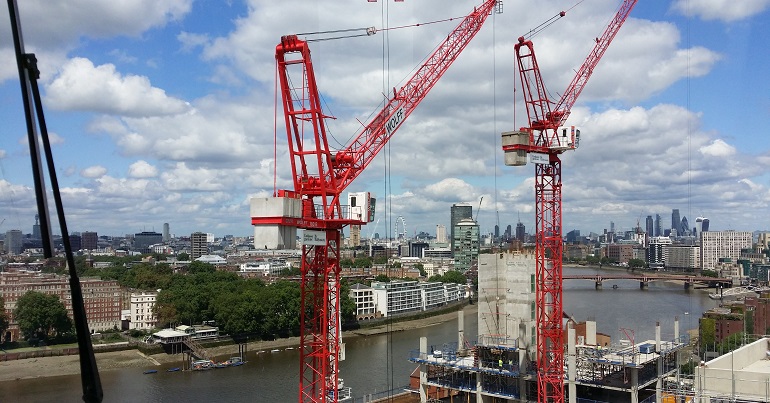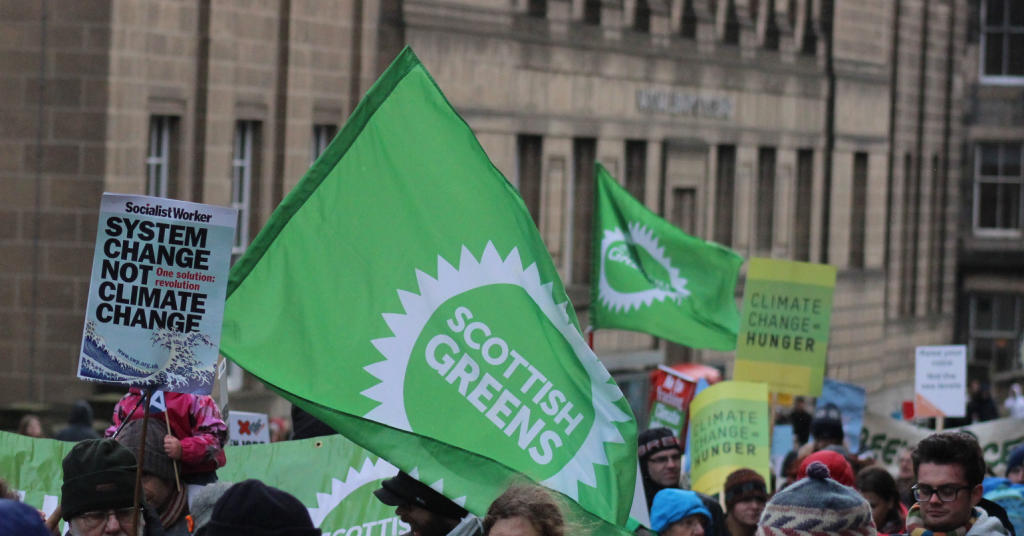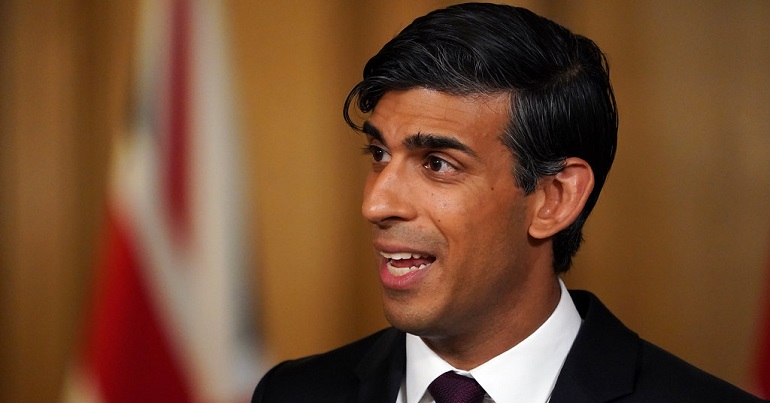We can’t build our way out of the climate emergency

For far too long public debate on the sufficiency of climate action has focused on how quickly we are rolling out wind turbines, solar panels or even nuclear power. Such a debate on how clean our electricity generation is – which makes up just a fraction of our overall energy use – distracts our gaze from the greater emissions associated with transport, both in the UK and globally. And it conveniently avoids us daring to ask whether new generation capacity replaces or adds to vast scale of fossil fuel use that underpins our whole economy.
Such a focus on electricity also masks the emissions associated with what we build and buy – emissions occurring in factories largely out of sight, and reflected in continued growth of freight and aviation as supply chains lengthen and travel soars, increasing greenhouse gas emissions whilst most other parts of the UK’s carbon footprint are reducing or flat-lining. This is highlighted in a recent report on the infrastructure requirements for zero carbon by Green House think tank: aviation and freight transport are the fastest growing sources of UK greenhouse gas emissions and sufficient climate action requires a switch from ever more infrastructure to curtailing demand.
In Roman mythology Janus – the god of doors – faces simultaneously into the past and into the future. Janus could be the god of current climate and economic policies, as they often face in opposing directions at the same time. Whilst claiming to be boldly striding towards a zero carbon future the UK government still remains firmly wedded to a business-as-usual that is accelerating us towards climate breakdown.
Facing up to climate reality requires new governance to redirect the economic drivers behind the continued expansion of our ‘built environment’ and infrastructure systems. This year the amount of man-made buildings, roads, infrastructure, and other materials existing worldwide, whether manufactured or constructed, exceeded the total weight of the natural world, at 1.1 trillion tonnes. Whilst the total carbon emissions since the start of industrial revolution have now reached at least twice as much. Imagine 380 billion elephants worth of a colourless gas floating around the world, and that this gas changes how much heat is trapped in our atmosphere. And that this is still rising at 220 elephants a second.
We must constrain the total amount of energy we use and material extraction if we are to manage down demand, and hence our carbon and ecological footprints. That in turn requires us to reverse the continued expansion of our infrastructure systems and built environment that continue to ratchet-up consumption. This must be reflected in our global governance to take collective responsibility for the trade and industrial supply chains that literally wrap our personal carbon footprints around the world. So, as well as living differently locally, sufficient climate action requires infrastructure and global economic systems to switch from continued expansion to being reformed and right-sized.
Big enough already
The notion that if you make the economy bigger we end up spending more is reflected in government appetites for ever more infrastructure investment around the world. But as well as requiring greater investment (competing with the finance needed to reduce emissions) this locks-in higher levels of energy and material use both in the construction itself and the production and consumption it fosters. Consider the link between the expansion of roads, and the demand for increased travel, fuel consumption and car production. Expanding roads drives up travel, which drives car production, which drives road construction and so on.
Yet engineers and economists typically overlook the way increasing the scale of our built environment drives up climate and environmental impacts. The UK’s National Infrastructure Strategy, published on 25 November 2020, sets out the infrastructure spending associated with the government’s current spending plans which includes significant road capital investment (including expansion) alongside some decarbonisation measures. It plans to increase road spending by 60%, which it claims to be the largest ever investment in the main road network. This accounts for over £27 billion in England alone and includes a series of bypasses along the A66 between Penrith and Scotch Corner, building the Lower Thames Crossing, and a road tunnel under Stonehenge. These investments will require significant carbon emissions – and foster greater transport emissions in the future.
Furthermore, on the 16th December 2020 the Court of Appeal ruled that it is fine for Heathrow airport to expand. The court argued that the decision to expand Heathrow could be legally based on outdated carbon targets, and thus could ignore the Paris Climate Agreement and the increasing scientific consensus that anything above a 1.5 degree rise in global temperatures would be catastrophic.
The government should recognise that this judgement reflects the flawed economic thinking that is still pervasive globally – that somehow it is possible to continue to expand the scale of our airports, roads, cities and the consumption that emanates from that locking-in much warmer future climates, ice melts, sea level rises, and so on – whilst simultaneously claiming to be accelerating climate action. We need to properly take account of the climate impacts of our infrastructure, trade and other major investment decisions. This must be properly reflected both in national policies and strategies, and the new global climate treaty due to agreed in Glasgow in 2021.
Need for joined-up thinking
At around the same time, also in early December 2020 the UK Government’s Committee on Climate Change (CCC) released its Sixth Carbon Budget Report. This stated that meeting the UK’s carbon budget for 2033-2038 requires us to reduce car use and air travel. As noted above this can’t just be about individual behaviour change but a radical shift from what is planned by government and given the green light by the current planning system.
Unsurprisingly, whilst the CCC report sets out what is required for the future, current government analysis shows a growing ‘climate gap‘ between UK carbon budgets and predicted emissions. This is even before the recent increase in ambition to reduce emissions by 68% by 2030 is considered.
With this gap in mind, Green House formally requested that the UK’s Committee on Climate Change (CCC) audit the UK’s new National Infrastructure Strategy, and the way that continued infrastructure investment and expansion of our built environment work against closing the carbon budget gap, and lock-in future greenhouse gas emissions. Their reply confirmed that the CCC is unable to audit particular strategies or announcements, except through their annual progress reports. Their reply also highlighted how their Sixth Carbon Budget report describes the Net Zero target as a major coordination and delivery challenge and the importance of the two Cabinet Committees for Climate Action – the Strategy Committee chaired by the Prime Minister and the Implementation Committee chaired by the BEIS Secretary of State. Stronger governance and coordination is needed both within government and to hold government to account. This must ensure our economic and infrastructure strategies are climate proof, to strengthen both national and devolved planning and be reflected in our impact across borders.
So where are we now? It would appear that despite all the glorious political sound bites, climate change remains a middle-order priority for government. Climate change still hardly features in major infrastructure investment decisions, and in neither national nor local planning decisions. And what about trade? Will climate governance be strengthened or further demoted by the UK’s post-Brexit EU, US and wider bilateral trade deals? Or will these take climate hypocrisy to a new level – negotiating trade deals that ignore climate change in the run up to hosting a climate conference, COP26 in Glasgow that up until now has ignored trade and imported consumption based emissions.
A climate emergency economy
To truly decarbonise the economy we must face up to a new set of ‘climate denials’.
Firstly, we must widen our vision to see how much the big picture needs to change. This requires us to not just accept the need to rapidly increase renewable energy generation but also, simultaneously, stop burning oil, coal and gas. This requires our decision makers to accept the (some would say elementary) fact that if you extract more oil from the ground we will burn more, as noted above.
Secondly, we must accept that we can’t keep expanding the scale of what is man-made whilst dealing with climate change. We need to stop looking two ways at once – turning a blind eye to climate polluting growth whilst investing in climate action. This affects not just our obsession with personal possessions but growth-addicted corporate investments. This requires our decision making to be cognisant of the fact that building more leads to us travelling more, heating more and buying more – and change what we invest in, privately and publicly.
We can’t build our way out of a climate emergency. Instead, we need to align the Treasury’s Green Book rules to constrain government investment to that sufficient to bring about a safe climate future as well as transform planning rules and end the laissez-faire governance of advertising that allows corporates to channel our addictions to ever wanting more.
Facing up to climate reality means transforming our underlying cultural norms and calling on governments and corporates around the world to reflect this in decisions on whether and how we invest in new capital – infrastructure and buildings, industrial investment and trade corridors. Climate justice and environment stewardship must no longer be discussed in separate conversations to trade and economics.
Climate and justice, not power and money, must frame the values that determine our common fate or future. That means declaring that our built environment and infrastructure systems are big enough already. So that, instead of facing both ways at the same time, we clearly set our hearts and minds on what it takes to face up to climate reality.
Endnote
This case for focusing on how carbon reduction relates to infrastructure investment is briefly explored in the new Green House report, Infrastructure Requirements for Zero Carbon: Why we can’t build our way out of the climate emergency. This explores how incompatible our society’s current and planned infrastructure is with the rapid decarbonisation of the UK economy needed to deliver on the climate emergency. We have focused on three key sectors: freight transport, aviation and steel, and considers what changes are required to bring these into line with zero carbon goals. As you know much of our existing industrial infrastructure, such as fossil fuel power stations and steel blast furnaces, is incompatible with zero carbon. And planned new transport infrastructure is still taking our economy in the wrong direction.
We also propose a decision-making ‘blockers and enablers’ toolkit, which includes aligning the Green Book process of government capital decisions within the government’s targets. This sits alongside our August 2020 report, Trade and Investment Requirements for Zero Carbon which focuses on the need to reduce our international trade, as well as our territorial emissions (see Trade and Investment Requirements for Zero Carbon, published August 2020).
PS. We hope you enjoyed this article. Bright Green has got big plans for the future to publish many more articles like this. You can help make that happen. Please donate to Bright Green now.




Leave a Reply